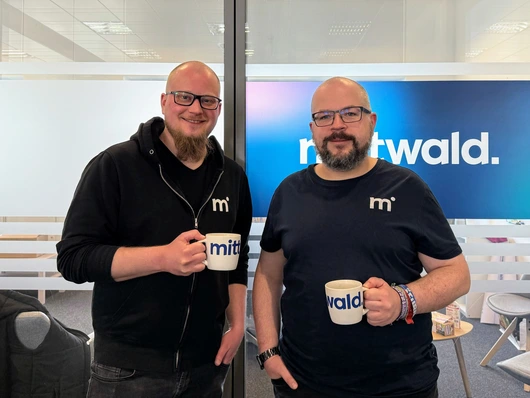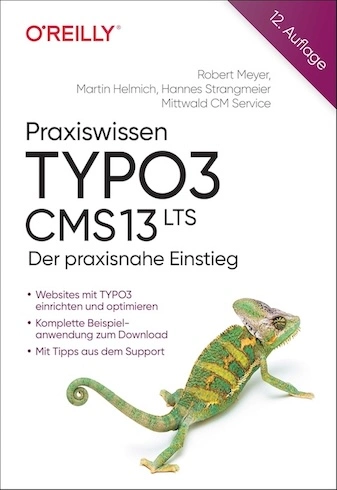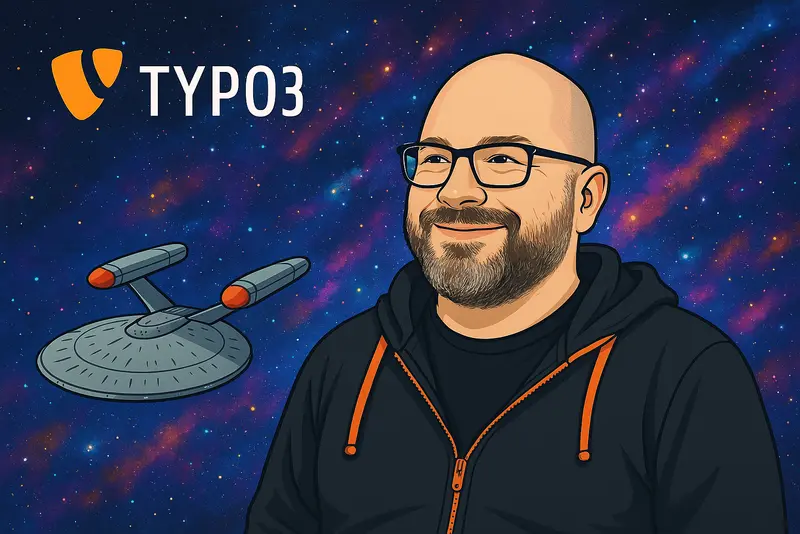TYPO3 is at a technological turning point in 2025 with version 13 LTS - more modern, more accessible and at the same time as powerful as ever. The 12th edition of "Praxiswissen TYPO3 CMS 13 LTS" is being published at exactly the right time, completely revised and adapted to the new version. The book has been the standard work for getting started with TYPO3 for over 20 years.
One of the authors: Martin Helmich, Head of Developer Relations at mittwald, TYPO3 expert since version 3.7 and committed open source advocate. In an interview with +Pluswerk, Martin talks about collaboration within the team of authors, technical innovations in TYPO3 13 and how the system can be made simpler and easier to understand for editors.

+Pluswerk: Welcome, Martin Helmich. We arranged to meet for an interview today because you are co-author of the new edition of the book "Praxiswissen TYPO3 CMS 13 LTS: Der praxisnahe Einstieg", which is due to be published at the end of July this year.
Martin Helmich: Yes, that's the plan - and it's already on the booksellers' websites.
+Pluswerk: You wrote the new book in a team of three, which I find very exciting. How did you distribute the tasks? Did everyone take on a chapter? Or was it more based on strengths and interests?
Martin Helmich: Robert Meyer is no longer actively involved in the book. He wrote the first edition 20 years ago. I took over from him at some point and have now brought Hannes on board as a co-author. On the one hand, we looked for chapters that didn't build directly on each other and could therefore be revised in parallel. On the other hand, everyone was able to contribute their strengths. Thanks to his many years of experience in mittwald support, for example, Hannes knows all the possible problems that users can have during installation and operation and also has a good knack for optimizations and best practices in the web area.

Old habits and new best practices
+Pluswerk: Working on a book with two people at the same time sounds exciting - and certainly more pleasant than writing alone because you get feedback more quickly.
Martin: Yes, exactly - you get immediate feedback. Instead of writing alone for months and then hearing that something isn't working, you get feedback from the co-author on the same day as to whether the new text makes sense or not. That makes the writing process much more dynamic.
+Pluswerk: Were there any chapters or topics that you discussed or wrestled with particularly intensively?
Martin: Absolutely. We had long discussions about which old habits we wanted to cut off. With TYPO3, many paths often lead to the same goal. Some ways used to be best practice and still work today, but are simply no longer up to date.
Let's start with the installation: Switching to Composer used to be quite disruptive, but today installation via Composer is standard. With TYPO3 V13, site sets were added, which offer completely new possibilities. So we had a discussion: Which features do we still mention - and which no longer?
For example, editing TypoScript in the backend: if you work with site sets, you don't really need this anymore, and we decided to mention it only as an excursus. In the main part of the book, however, we consistently focus on the new best practices.
+Pluswerk: Did you also have to completely rewrite certain chapters or content?
Martin: Yes, for example the chapter on the local development environment. We used to describe Docker setups with Docker Compose, which was quite cumbersome. Today we recommend DDEV. That's why we rewrote the chapter, including tips on using it under Windows with WSL. This was necessary because we didn't want to leave Windows users behind. Fortunately, my co-author Hannes Strangmeier is a Windows user himself, which helped.
+Pluswerk: Let's move on to the new TYPO3 version: What new features do you find particularly exciting, especially for agencies and development teams?
Martin: I'll go back to the site sets because they are a good example. They follow the development towards independent site packages. You can now create a site package that contains all configurations and can be reused in other projects. This is not only practical, but also the basis for future features such as themes, which will probably come in TYPO3 14 or 15.
Making TYPO3 easier - for editors and developers
+Pluswerk: Rumor has it that TYPO3 is often considered complex or difficult to access. What can your book or the TYPO3 community do to make it easier to get started?
Martin: One big step is standardization: TYPO3 is getting closer and closer to the PHP standard ecosystem. Composer installation, Symfony components - these are things that developers are familiar with.
Nevertheless, TYPO3 remains a complex system, especially for editors. That's why we show in the book how the backend can be sensibly reduced for editors. Instead of 100 buttons, there are only the five that are really needed. This significantly lowers the barrier to entry, but it is up to the integrators to set up the system accordingly.
+Pluswerk: If you compare TYPO3 in 2025 with other open source CMS such as WordPress or Drupal - where do you see TYPO3's strengths?
Martin: TYPO3 is strong in complex setups with granular rights systems, flexible extensibility and a detailed editorial structure. This makes it attractive for enterprise environments.
I see the actual competition less in WordPress or Drupal, but rather in commercial systems such as Adobe Experience Manager, Storyblok or Contentful, the market is relatively large here. The community is happy to see anyone who decides to use open source. In addition, the individual open source communities have been converging more and more recently - at TYPO3 events, you've long since met Drupal or Wordpress developers, and it's often the same the other way round.
+Pluswerk: What does your job title "Developer Relations" at mittwald actually mean and how does it flow into the book?
Martin: A large part of my work is community engagement, developer education and exchanging ideas with developers. I travel a lot as a speaker and write regularly. Writing the book fits in perfectly and also benefits from the fact that I am well connected in the TYPO3 community.
+Pluswerk: Finally, a slightly different question: you're a sci-fi fan. If TYPO3 were a spaceship, which series would it be from and what would it look like?
Martin: (laughs) Difficult question. I'll put the Star Wars franchise to one side, because analogies to the Empire or the Siths somehow don't fit so well. I'll go over to the Star Trek universe.
The Borg cube is out for now, that would be too negative. I would lean more towards the Galaxy class from Star Trek: A large, versatile research vessel that can be used flexibly - peaceful, but also capable of fighting if necessary. And of course: in a post-capitalist society where reputation is the new currency, people no longer work just for money - just like in the open source world.
The interview with Martin Helmich shows that TYPO3 is more than just technology - it is a community project that is constantly evolving. The book Praxiswissen TYPO3 CMS 13 LTS helps you to find a good introduction to the TYPO3 universe.

TYPO3 thinking ahead
TYPO3 is constantly evolving - not only as a CMS, but also as a community project with attitude and responsibility. The book Praxiswissen TYPO3 CMS 13 LTS takes this claim into account: it is not just a manual, but a guide for all those who really want to understand the system and use it sensibly. Martin Helmich and Hannes Strangmeier show that a reference book and a community are two sides of the same coin. Thank you for the interview - and we look forward to TYPO3 13 LTS in practice.


